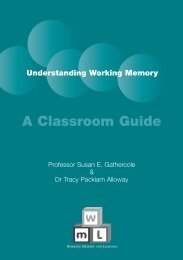early-childhood-education-and-care-pedagogy-review-england.pdf?utm_content=bufferb49b1&utm_medium=social&utm_source=twitter
early-childhood-education-and-care-pedagogy-review-england.pdf?utm_content=bufferb49b1&utm_medium=social&utm_source=twitter
early-childhood-education-and-care-pedagogy-review-england.pdf?utm_content=bufferb49b1&utm_medium=social&utm_source=twitter
Create successful ePaper yourself
Turn your PDF publications into a flip-book with our unique Google optimized e-Paper software.
78 – CHAPTER 8: POLICIES INFLUENCING PEDAGOGICAL APPROACH AND PRACTICEECEC organisation of settingsHow the provision of ECEC is organised can greatly influence <strong>pedagogy</strong>. Such factorsinclude whether settings serve all children in the ECEC age range, or are split between differentage groups, <strong>and</strong> the type of ECEC provided (<strong>care</strong>, after-school <strong>care</strong>, <strong>early</strong> <strong>education</strong>, playgroups),all of which influences the <strong>pedagogy</strong> of ECEC staff. This is usually also reflected in thecurriculum, as well in separate curricula for different age groups <strong>and</strong>/or settings, if a split systemis in place. The organisation of ECEC at national level <strong>and</strong> the different types of settings wereexplained in Chapter 4. This section will focus more on whether ECEC is aligned, or evenintegrated, with primary school. This also influences <strong>pedagogy</strong>, since preschool settings inprimary schools can have a pedagogical approach that more closely resembles school, meaningthat the <strong>pedagogy</strong> in these countries is focused on academic <strong>education</strong> rather than playing <strong>and</strong>simple child<strong>care</strong>.In sum, France is the only one of the case-study countries where <strong>early</strong> years <strong>pedagogy</strong> isexplicitly aligned with the formal school system, though this applies only to the <strong>education</strong> sectorof the French ECEC system. The close alignment between the two settings has been criticisedbecause it is argued that it discourages appropriate pedagogical practice in the preschool setting<strong>and</strong> encourages practices used in primary schools. One advantage, however, is that teachers <strong>and</strong>administrators meet regularly to discuss children’s learning <strong>and</strong> development. This helps toidentify difficulties <strong>and</strong> smoothes the children's transition from the école maternelle to theprimary school. In other countries, including Engl<strong>and</strong> <strong>and</strong> Japan, ECEC <strong>and</strong> primary <strong>education</strong>are aligned with each other, whereas in Denmark, Germany <strong>and</strong> New Zeal<strong>and</strong>, a strict division ismade between ECEC <strong>and</strong> primary schooling. However, measures in these countries have easedthe transition from ECEC to elementary <strong>education</strong> by interposing a transition year, or implicitlylinking certain aspects of the curriculum framework with primary <strong>education</strong>.Engl<strong>and</strong>In Engl<strong>and</strong>, <strong>early</strong> years <strong>education</strong> is becoming increasingly aligned with formal schoolsettings. This is not only in view of the Early Years Professional Programme (EYPP) <strong>and</strong> EarlyYears Teachers Programme (EYTP), but also through changes in the <strong>early</strong> years curriculum. In2012, the EYFS reshaped its learning areas <strong>and</strong> goals in accordance, where possible, with thebaseline for the national curriculum (DfE, 2012). These changes have been preserved in thenewest version of EYFS (2014), which directly specifies 17 <strong>early</strong> learning goals in its sevenlearning areas. How far these goals have been met is assessed in the EYFS profile of each child.Early years practitioners are asked to indicate whether or not the child is meeting the expectedlevels of development, <strong>and</strong> to describe the child’s abilities in relation to the three prime learningareas. The profile is then given to the child’s Year 1 teacher, to allow activities to be tailored tothe child’s needs in a formal school environment.DenmarkIn Denmark, ECEC settings <strong>and</strong> primary school are differentiated both in their pedagogical<strong>and</strong> <strong>education</strong>al approach <strong>and</strong> expectations. The legislation promotes child well-being in bothinstitutions. Day-<strong>care</strong> facilities are encouraged by the Day-Care Facilities Act (MFCA, 2007) tohelp ease the transition from day <strong>care</strong> to primary school by nurturing children's basic competences<strong>and</strong> general motivation for learning. As a result, ECEC for children from birth to 6 years focuseson holistic child development, rather than using ECEC as a means to merely prepare children forprimary school <strong>and</strong> stimulate cognitive development only. Denmark aims at providing childrenwith <strong>early</strong> development opportunities through play, addressing holistic development subjects thatare cognitive <strong>and</strong> socio-emotional, <strong>and</strong> stimulate well-being. Denmark implements differentmeasures to ensure that children transition well between ECEC <strong>and</strong> primary <strong>education</strong>. Since2008, a previously optional year of preschool class (at International St<strong>and</strong>ard of Classification ofEARLY CHILDHOOD EDUCATION AND CARE PEDAGOGY REVIEW: ENGLAND © OECD 2015



